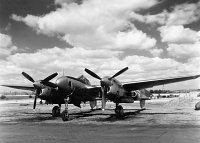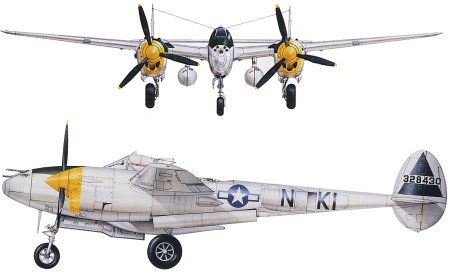
Home »
USA » Lockheed P-38 Lightning
Lockheed P-38 Lightning
Many believe the Lockheed P-38 Lightning was the finest American fighter of World War II. The twin-boomed P-38 was fast, heavily-armed and extremely versatile. While it had trouble matching single-engine fighters like the Messerschmitt 109 and Focke-Wulf 190, the Lightning was very manoeuvrable for such a big machine, and in capable hands its could hold its own. The P-38 more than held its own in the South West Pacific, where the aircraft was flown by Major Richard I. Bong and Major Thomas B.McGuire, America's top scoring aces of all time.
As late as 1944, when Mustangs were sweeping the skies clear of foes, a poll in flying classes showed that student pilots' 'most wanted' aircraft was the Lockheed P-38 Lightning, the design of which dated back to 1937.
The P-38 was rugged and versatile and because of its low drag aerodynamic shape and heavy weight it accelerated to high speeds faster than any previous warplane. A potent fighter and a superb fighter bomber, it also flew as a night-fighter, reconnaissance aircraft, ambulance, torpedo-bomber and target tug.
More than 100 US Army squadrons flew the P-38, which was produced in at least two-dozen versions. In the Pacific, P-38 pilots carried out the long-range intercept mission which downed and killed Japan's Admiral Isoroku Yamamoto, a planner of the Pearl Harbor attack. In the Mediterranean, Luftwaffe pilots showed respect for the Lightning by calling it der gabelschwanz Teufel (the fork-tailed devil).
The ultimate P-38L model was flown by Dick Bong and Tommy McGuire, who with 40 and 38 victories, respectively, were the most successful American Fighter pilots in history.
 |
 |
 |
| The F-5 reconnaissance Lightning performed dangerous lone missions without any armament. |
RAF Lightning were aearly aircraft with low-rated engines and had all the faults and none of the advantages of later machines. They were not popular with British pilots. |
The P-38M was one of the fastest night-fighters of the war, despite the added weight of radar and a second crewmember. |
|
Lockheed P-38 Lightning (Technical Specification) |
| Role |
Single-seat fighter and fighter-bomber |
| Manufacturer |
Lockheed |
| Maximum Speed |
666 kmh (414 mph) |
| Maximum Range |
765 km (475 miles) |
| Ceiling |
13,400 meters (44,000 feet) |
Weight
Empty
Maximum Takeoff |
5,806 kg (12,800 lbs)
9,798 kg (21,600 lbs) |
Dimensions
Wingspan
Length
Height
Wing Area |
15.85 meters (52 ft)
11.53 meters (37 ft 10 in)
3.00 meters (9 ft 10 in)
30.42 square meters (327 sq ft) |
| Engines |
Two turbo-charged Allison V-1710-111-113 in-line piston engine each providing 1194-kW (1,600 hp) |
| Armament |
One 20 mm (0.79 in) cannon
Four 12.7 mm (0.50 cal) machine-guns
plus up to 1,450 kg (3,197 lbs) of ordnance usually
Two 454 kg (1,000 lbs) or 726 kg (1,600 lbs) bombs
Ten 127 mm (5 in) rocket projectiles under wings |
Photo Gallery
Click here to submit your photo
| Have A Passion For Aircraft? |
Subscribe to our 14 series FREE newsletter
delivered weekly on World War 2 Aircraft factfile... |
| NB:- We hate spam as much as you do, so your email address will NEVER be shared with or sold to anyone else. That's a Guarantee. |
|
|







